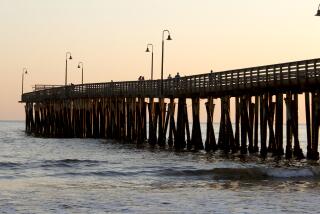Beachfront NIMBYs
ALTHOUGH thousands of $400-a-night hotel rooms have sprung up along our coastline in the past decades, few if any new campgrounds, parks or other public facilities have been built to accommodate the other 98% of Californians who can’t afford to pay five-star prices yet still covet a beach experience beyond a towel on the sand.
What most people don’t realize is that the state of California owns a marvelous chunk of unused beachfront property in Santa Monica, one that could be converted to a park and beach club everyone could enjoy, unless a few mega-wealthy NIMBYs succeed in blocking the project.
Less than two miles north of the Santa Monica Pier lies a five-acre estate once owned by William Randolph Hearst. Built with the help of legendary architect Julia Morgan (who designed Hearst Castle in San Simeon and the Herald-Examiner building downtown), the property was known as the Marion Davies estate. The tycoon’s mistress, a silent movie star, hosted famously lavish Hollywood parties there in the 1930s.
Hearst sold it in the 1940s. The state bought the land in 1960 and let the property be managed by the city of Santa Monica, which rented it out to the private Sand & Sea Club for a while, then opened it sporadically as a public space. But since the 1994 Northridge earthquake, this absurdly prime bit of real estate has been empty, left to slowly decay, the victim of a lack of funds.
For years, government officials and community activists like me have worked on a plan to transform it into the crown jewel of California public beach facilities. For a modest day-use fee, anyone could enjoy the luxurious swimming pool with its historic tiles, sun deck with lounge chairs, volleyball and paddle tennis courts, small event rooms, children’s play area, picnic tables and much more. Nearly all the renovation funds would come from a visionary $28-million Annenberg Foundation grant. Santa Monica approved the project in May. Considering that the land is valued at more than $50 million, the proposal is truly a once-in-a-lifetime opportunity.
But a group called the Palisades Beach Property Owners Assn. filed a lawsuit in June to derail the project. Four deep-pocketed owners of nearby beach houses — though not the immediate neighbors of the estate at 415 Pacific Coast Highway — are seizing on any excuse to tie up the plan in court.
They complain that the new club would destroy the locker building, which is included on the California Register of Historical Resources. But that structure, which postdates Hearst by decades, was placed on the registry by mistake, which the State Historical Resources Commission acknowledged when removing it from the list last month. The beach club proposal, in fact, has won raves from preservationists.
The property owners also worry about traffic safety and parking. But in fact there are about 300 parking slots on site, and the city has put in a request to install a traffic light. Concerns about noise are being addressed by a ban on all outside amplified music after nightfall. Curfews would be 10 p.m. on weeknights, 11 p.m. on weekends, and there would be 24-hour security. In short, the reasonable issues are being dealt with.
The Beach Property Owners Assn.’s arguments are eerily similar to those it made on another public access project — one that now seems absurdly noncontroversial. The bike path that winds along the coast of Santa Monica Bay is world famous, one of Southern California’s most popular public recreational offerings for tourists and locals alike. But for years the bike route came to an abrupt end on either side of the “Gold Coast” stretch of houses because of opposition from the association, which claimed (among other silly things) that the bike path would be harmful because it would mean paving over too much sand, depriving the public of beach to sit on.
Thankfully, community pressure and the intervention of more moderate neighbors persuaded the property owners to back down — but not before that stretch was delayed by many years.
This time around, we don’t have many spare years to waste. The Annenberg grant, sensibly, has a deadline of 2010 for opening the facility. Any further extensions would require renegotiation with the design team and cost increases. Substantial delays, such as those caused by a lengthy court fight, could effectively kill the project and likely scuttle any chance this generation has for a public beach club at the site — something the opposition is banking on.
In short, the community needs to act now. Fortunately, the Annenberg Foundation has appeared committed throughout the project, and recently the more reasonable beachfront neighbors began pushing for a settlement with Santa Monica, which has been bending over backward to close a deal.
This is the best and perhaps last chance to preserve what remains of the historic Hearst architecture and to build a monument to public beach access. It is, after all, our beach.
More to Read
Sign up for Essential California
The most important California stories and recommendations in your inbox every morning.
You may occasionally receive promotional content from the Los Angeles Times.










